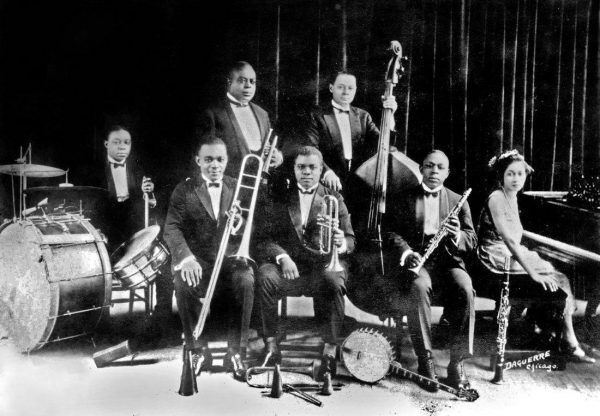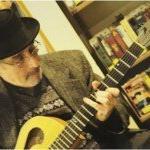While a really swinging beat or rhythm will make sophisticated dancers perform quite extraordinary terpsichorean feats, we also know that the vast amount of social dancing in the Western world occurs to the dullest, stiffest unswinging ‘clomp-clomp’ rhythms.”—Gunther Schuller
On April 5, 1923, a band of Black Southern musicians gathered inside a wooden recording shack at Richmond, Indiana, about to cut their first sides. Their sound contended with that of the Whitewater River rolling outside and the “thundering steam locomotives” servicing the adjacent Starr piano factory. And Indiana, it turned out, boasted the largest KKK contingent of any state. Today, any reasonable horn player would have bolted at thought of signing on.
But these refugees had made it North. Along with thousands of other Southern Negroes, they had left a larger world of blind bigotry and violence, wanting, as the great Creole reedman Sidney Bechet has written, to be “let alone so they could be human.” The street sound of jazz would become their wormhole to humanity.
At the session, led by the resolute Joe “King” Oliver with his seven-piece Creole Jazz Band, a just-turned-21 dishwasher, grave cleaner, and junk-wagon hand let loose his first-ever recorded horn solo. For years, Oliver had urged his young acolyte to play it straight, stick to the “lead.” But the student saw a longer track.
Child of a new, emancipated century, Louis “Dipper” Armstrong had joined the band a year earlier, having traveled from his empty-cupboard New Orleans neighborhood on the Illinois Central Railroad, rolling and clanking nine hundred miles north past Montgomery, Jackson, Paducah, Memphis, and Champaign, pulling into Chicago, the new band’s home base.
When he stepped from the mammoth Illinois Central terminal and onto Michigan Avenue, he found himself in Richard Wright’s “great iron city…so deadly dramatic and stimulating, we caught whispers of the meanings that life could have, and we were pushed and pounded by facts much too big for us.”
Adept though he was, young Armstrong felt the threat. A taxi dropped him in Bronzeville amidst thousands of yearning Black migrants who had left the South “as though they were fleeing some curse,” wrote Isabel Wilkerson. “I was a little shaky about going inside,” Armstrong wrote about Oliver’s venue, the cavernous Lincoln Gardens dance hall. “For a moment I wondered if I should. Then, too, I started wondering if I could hold my own with such a fine band.” Once inside, he added, “The lobby seemed to be a block long, so long that I thought I was never going to reach the bandstand.”

The geometry represented both Louis’ long haul to come and the musical distance he had started traveling. Oliver’s band sound, described by Eddie Condon as “hypnosis at first hearing,” would have made anyone with ears want to jump out of his skin.
Nine months later at Richmond, the first audible signpost of the distance popped through in the Oliver band’s take of Chimes Blues, a kind of chamber-style, horn-based septet in straight time. One could almost think minuet—not jazz.
Until the walls moved. At the denouement, Armstrong’s cornet emerged out of the woods, from another time and territory, on his way to a distant destination. At this event, said the jazz critic Gary Giddins, “You heard the future.”
“Timeless” may have said it better—because Louis came in swinging, an emergent youth riding a pendulum. He had been “cut loose”—a term used in New Orleans funeral parades when the casket goes into the ground, the soul rises, and the band starts to romp.
Years later, Frank Sinatra put it keenly: “Jazz is about the moment you’re in. Being modern’s not about the future, it’s about the present.”
♫ ♫ ♫ ♫
“Swing” wasn’t just about music: It meant transiting from buried to risen, enslaved to free, there to here. “Nothing happens until something moves,” said Einstein. Swing meant breaking from gravity. And it surfaced way before the “Swing Era.”
In 1854, Frederick Law Olmsted, then a journalist, observed Southern plantation slaves “returning from their toil after a thundershower”:
First came, led by an old driver carrying a whip, forty of the largest and strongest women I ever saw together…; they carried themselves loftily, each having a hoe over the shoulder, and walking with a free, powerful swing, like chasseurs on the march.
In 1863, Continental Monthly covered slave praise meetings and ring shouts. The author noted,
The physical exertion, which is really very great…seems never to weary them in the least, and they frequently keep up a shout for hours, resting only for brief intervals between the different songs….Their ‘shouting’ reveals a suppleness of limb and peculiar grace of motion beyond the power of our dancing masters to impart.
As the pendulum swings, its resonance alone practically keeps it moving. In the swing moment, past and future vanish. There is no place to go, no “way” to be–only freedom of motion and gratitude for living. In his Why New Orleans Matters, Tom Piazza wrote of the Crescent City’s downtrodden:
And when a parade passes, whether it is for one of the Social Aid and Pleasure Club anniversaries or for a funeral, they dance behind it, and laugh and take a little drink, because they know better than anyone that life is short and hard and often bitter but it is at least life.
In 1892, the New Orleans trombonist George Filhe recalled that he played [solo cornet] with Cousto & Desdunes….Played jazz, would always swing the music, that was their novelty….Younger musicians about 1892 began to ‘swing.’” Filhe would later play with Joe Oliver.
Swing involves free rise-and-fall—the “sway” of living. Webster’s New World defines “swing” as “to sway or move backward and forward with regular movement, as a freely hanging object….” In 1899, New England Magazine published “Hymns of the Slave and the Freedman”: “It is a peculiarity of the Negro music that it can nearly all be swayed to and timed with the patting of the foot. No matter how irregular it appears to be, one who sways backward and forward and pats his foot finds the rhythm perfect.”
The freedom brings joy. In 1856, Dwight’s Journal published “Songs of the Blacks.”
Their joy and grief are not pent up in the heart but find instant expression in their eyes and voice….No song of a concert room ever thrilled us like one of these simple African airs, heard afar off in the stillness of a summer night.” And: “In these wild bursts of melody he seems to be giving utterance to the exultant liberty of soul which no chains can bind, and no oppression subdue.
As Armstrong wrote of the brass band parades, “All the people would leave their worries behind.”
♫ ♫ ♫ ♫
Writing about the 1895-96 period, Variety’s NOLA correspondent said, “At an old Negro dance hall, the accompanying music was played by a colored band, which…often repeated the same selection, but never played it the same way twice.”
In the swing moment—the “pocket,” there is no “previous moment,” so nothing can ever happen the same way twice. Even Shelley Manne agreed: “”We never play anything the same way once,” he remarked to an audience at his Los Angeles club.
Finally, and again from Schuller: “For a condition of ‘swing’ to exist, any calculating, studying, and practicing must have been translated into a feeling.”
Certainly as Emancipation came on and folks snapped their chains, there were plenty of feelings to go around.
Writing in 1917 of plantation song, the Black classical composer and arranger Harry Burleigh said, “The cadences of sorrow invariably turn to joy, and the message is every soul will come, and man—every man—will be free.”
Peter Gerler has written about jazz since the early 1990s. He has been published in American Legacy, DownBeat, JazzTimes, Humanities, The Boston Globe, New Orleans Gambit, Moultrie Observer, WBGO, Upbeat, www.jazz.com, www.nejazz.com, and other venues. He has presented on early jazz at Satchmo Summerfest, River Road African American Museum, Classic Jazz at Lincoln Library, Cambridge Center for Adult Education, Newton Lifetime Learning, and numerous senior facilities in the Boston area. Visit him online at www.jazztalks.com.























